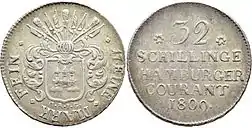Hamburg mark
The Hamburg Mark refers to two distinct currencies issued in the city of Hamburg until 1875:
- The Hamburg Mark Banco, a bank money and an accounting unit, and
- The Hamburg Mark Courant, an actual coin.
| Hamburger Mark (German) | |
|---|---|
 32 Schilling coin 1809 | |
| Unit | |
| Plural | Mark |
| Denominations | |
| Subunit | |
| 1⁄16 | Schilling |
| 1⁄192 | Pfennig |
| Plural | |
| Schilling | Schillinge |
| Pfennig | Pfennige |
| Demographics | |
| User(s) | Hamburg, British Heligoland |

Each mark is divided into 16 schilling, each of 12 pfennig. Three marks were equal to a Reichsthaler, Germany's main unit of currency which the Hamburger Bank (Bank of Hamburg) defined and maintained until 1875.
Hamburg Mark Banco
The Hamburg Mark Banco was a form of bank money created by the Hamburger Bank in 1619 in order to provide a more reliable medium of exchange in the midst of the monetary chaos of the Kipper und Wipperzeit. It accepted silver of verified weight from customers and credited their accounts with a Reichsthaler equivalent unit called the Hamburg Reichsthaler Banco, equal to 3 Hamburg Marks Banco and which subdivided further as
- 1 Reichsthaler Banco = 3 Marks Banco, each of 16 schillings, and also as
- 1 Reichsthaler Banco = 0.4 Pound Flemish, each of 20 schillings Flemish or 240 grotes Flemish.
This Mark Banco turned out to be one of Europe's most stable currencies. While the Reichsthaler was originally defined as 25.984 grams (1⁄9th a Cologne mark, or 233.856 g) fine silver, the Bank of Amsterdam's lower standard for the Dutch rijksdaalder of 25.4 g prevailed for the next two centuries. From 1770 the Hamburger Bank accepted bullion and coin, buying one Cologne mark of fine silver for 275⁄8 marks banco (95⁄24 thalers, or 25.40 g per thaler), and selling it for 273⁄4 marks (91⁄4 thalers, or 25.28 g per thaler).[1] The reichsthaler banco of Hamburg and Amsterdam was also equivalent to the Danish rigsdaler specie and the Norwegian rigsdaler specie.[2]
The Vienna Monetary Treaty of 1857 unified the various German currencies with the Vereinsthaler of 162⁄3 g fine silver, with Hamburg's Reichsthaler Banco worth 1.5169 Vereinsthaler. With full German unification in 1871 and the introduction of a uniform German gold mark currency in 1873 there was little need for an institution like the Hamburger Bank to verify the value of the currency of a unified Germany. The bank was closed in 1875 with the Reichsthaler Banco or 3 Marks Banco converted to 4.5 gold marks.
Hamburg Mark Courant or Currency
Even with the existence of standardized currency denominated in Reichsthalers and Marks Banco, it was desired to issue coins (or courant) in Northern Germany valued at a fraction of these standard units. Hamburg first issued local currency in 1667 at a tale of 1 Cologne Mark = 10.5 thalers courant = 31.5 marks courant (the Zinnaische standard). In 1690 it then decided to follow the standard of Lübeck issued at a tale of 1 Cologne Mark = 111⁄3 thalers = 34 marks courant. This Hamburg Mark Courant was worth 27.625/34 = 13⁄16th of a Hamburg Mark Banco (or 6.88 g fine silver) and was also divided into 16 schillings courant.[3]
A mostly similar currency system was used in Denmark, Norway and Schleswig-Holstein, but with a slightly lower thaler courant worth 4⁄5 the Reichsthaler specie, so that the latter equalled 60 schillings courant (or 120 skillings Danske in Denmark and Norway).[4]
Prussian thalers and Vereinsthalers became more common in Hamburg after 1840 and began to be exchanged for a higher price of 21⁄2 marks courant, thus implying a lower tale of 35 marks courant or 6.67 g fine silver. In 1875 the Hamburg Mark Courant was retired and converted to 1.2 German gold marks.
References
- Shaw, William Arthur (1896). "The History of Currency, 1252-1894: Being an Account of the Gold and Silver Moneys and Monetary Standards of Europe and America, Together with an Examination of the Effects of Currency and Exchange Phenomena on Commercial and National Progress and Well-being".
- Seyd, Ernest (1868). Bullion and Foreign Exchanges Theoretically and Practically Considered: Followed by a Defence of the Double Valuation, with Special Reference to the Proposed System of Universal Coinage. E. Wilson.
- Shaw, William Arthur (1896). "The History of Currency, 1252-1894: Being an Account of the Gold and Silver Moneys and Monetary Standards of Europe and America, Together with an Examination of the Effects of Currency and Exchange Phenomena on Commercial and National Progress and Well-being".
- Eckfeldt, Jacob R. (1842). "A Manual of Gold and Silver Coins of All Nations Struck within the Past Century: Showing Their History, and Legal Basis and Their Actual Weight, Fineness, and Value, Chiefly from Original and Recent Assays".